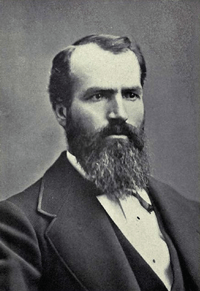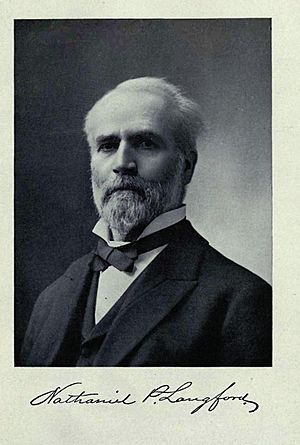Nathaniel P. Langford facts for kids
Quick facts for kids
Nathaniel P. Langford
|
|
|---|---|

1870 Portrait of Nathaniel P. Langford
|
|
| Born | August 9, 1832 New York City
|
| Died | October 18, 1911 (aged 79) Minnesota
|
| Occupation | Park superintendent, vigilante, historian |
| Signature | |
Nathaniel Pitt Langford (born August 9, 1832 – died October 18, 1911) was an American explorer, businessman, and historian. He was from Saint Paul, Minnesota. Langford played a very important role in the early days of the Montana gold rush. He also helped create Yellowstone National Park.
Contents
Early Life and Work
Langford was born in Upstate New York. In 1854, he moved to Saint Paul, Minnesota. He worked as a banker there. He also helped invest in the Saint Anthony Park neighborhood.
Journey to the Gold Fields
On June 16, 1862, Langford joined the Northern Overland Expedition. This group, led by Captain James L. Fisk, left Saint Paul. Their goal was to create a wagon road to the gold mines near the Salmon River in the Rocky Mountains.
The expedition ended up at the Grasshopper Creek gold fields. This area was soon named Bannack, Montana. Langford and other businessmen started freight companies and a saw mill there. They also set up other businesses to help the growing gold mining towns.
Helping Keep Order
Langford was also part of a group called the Montana Vigilantes. These were citizens who took on the job of keeping law and order. They dealt with problems in towns like Virginia City and Bannack, Montana between 1863 and 1864.
In 1890, Langford wrote a book called Vigilante Days and Ways. This book told the story of how people tried to create justice in the early American Old West.
Working for the Government
In 1864, the Montana Territory was officially created. Soon after, Langford was given an important job. He became the Collector of Internal Revenue and a National Bank Examiner. He held these government positions for five years.
Exploring and Creating Yellowstone
Langford was a member of the 1870 Washburn–Langford–Doane Expedition. This group explored parts of the area that would soon become Yellowstone National Park. During this trip, Langford and another explorer, Doane, climbed a mountain. This mountain, 10,623 feet (3,238 m) tall, was named Mount Langford after him. It is located in the Absaroka Range, east of Yellowstone Lake.
First Park Superintendent
After his part in the Washburn expedition, Langford was chosen as the very first superintendent of Yellowstone National Park. Because of his initials, N.P., he was often called National Park Langford.
However, there was no money to pay him a salary for this new job. So, he had to work other jobs to earn a living. This meant Langford had little time to manage the park. He only visited the park twice during his five years as superintendent. His first visit was as a guest on another expedition in 1872. His second visit, in 1874, was to remove a man named Matthew McGuirk. McGuirk wrongly claimed to own the Boiling River, a hot spring in the park.
Langford faced many challenges. He had no salary, no money to protect the park, and no legal power to stop people from harming its wildlife or natural features. Due to political pressure, Langford was removed from his position in 1877. He was replaced by Philetus W. Norris. In 1905, Langford published his book, Diary of the Washburn Expedition to the Yellowstone and Firehole In the Year 1870. This book gave a detailed look at the expedition from his point of view.
Later Life as a Historian
After his time with Yellowstone, Langford went back to his home state of Minnesota. He began a new career as a historian of the American West. Before he passed away, he served as the President and on the Board of Directors of the Minnesota Historical Society.
See also
 In Spanish: Nathaniel P. Langford para niños
In Spanish: Nathaniel P. Langford para niños



